The Razer Edge Review
by Vivek Gowri on March 28, 2013 11:00 AM EST- Posted in
- Tablets
- Mobile
- Razer
- Razer Edge
Performance
Now for the good parts. We’re actually pretty familiar with the computing platform behind the Edge. The ultra-low voltage IVB parts are commonly found in ultrabooks and are some of the AT mobile team’s favorite mobile processors right now. I’m not the only one, Dustin just rhapsodized about the ULV Core i5s in his review of the updated Dell XPS 13 last week. The usable performance and reasonable power draw on offer are just that fantastic, and these CPUs really represent the sweet spot of the market right now. I’m not sure that the additional CPU headroom of the i7s is really necessary or worth the additional cost; the 100-200MHz clock speed bumps are pretty incremental. The only really compelling thing about the i7 SKUs is their ability to hit 3.0-3.1GHz on Turbo, a solid 400MHz higher than the corresponding i5 parts.
The other thing is that I’m seeing a lot of cases where there will be two SKUs on offer – one with an i5, 4GB RAM, and a 64GB/128GB SSD, and then a high end one that offers spec bumps across the board – i7, 8GB, and 128GB/256GB. We’re moving away from the early 2000s Dell/HP/Gateway-era of pick your component computing, so the decision between i5 and i7 chips might actually be hinge on the rest of the package, as is the case with the Edge.
Anyways, that’s diverging a bit. We’re very familiar with both of the CPUs used by the Edge from various ultrabooks; in particular, the i5-3317U is the heart of my trusty ASUS Zenbook Prime and I just recently looked at the i7-3517U in my review of the Vizio CT15. The i7-3517U has a base clock speed of 1.9GHz and a max turbo of 3.0GHz, along with HD 4000 onboard graphics (350MHz base clock, 1.15GHz max). It performs roughly where we’d expect, and I’d also like to highlight the relative lack of differences between the i5 and i7 ULV SKUs here.
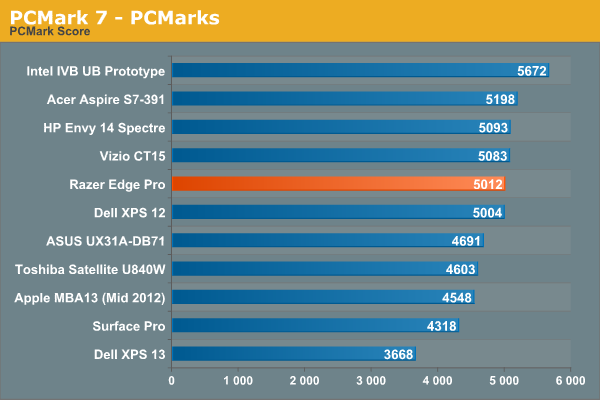
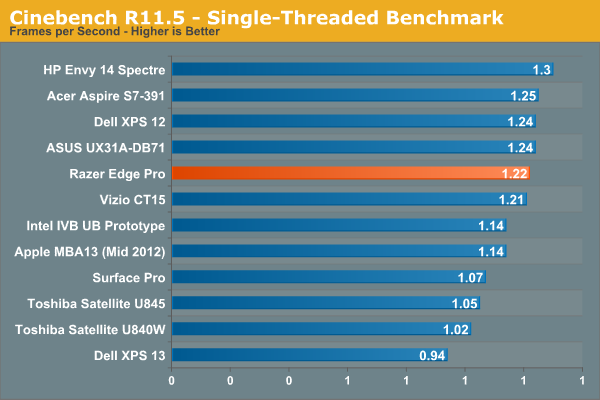
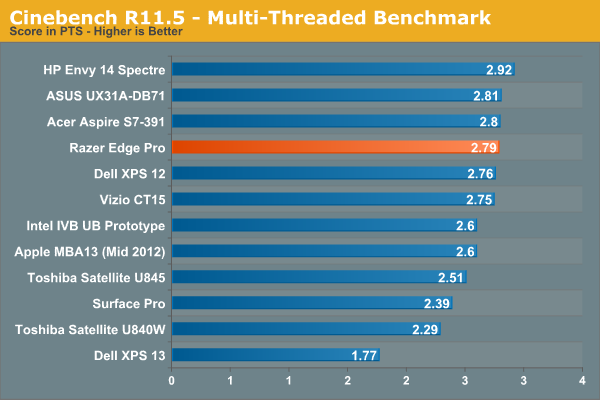
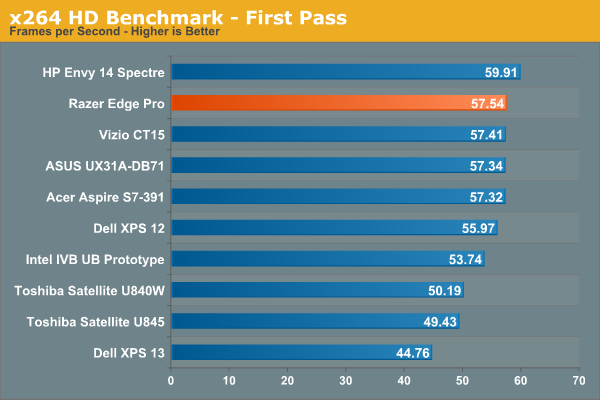
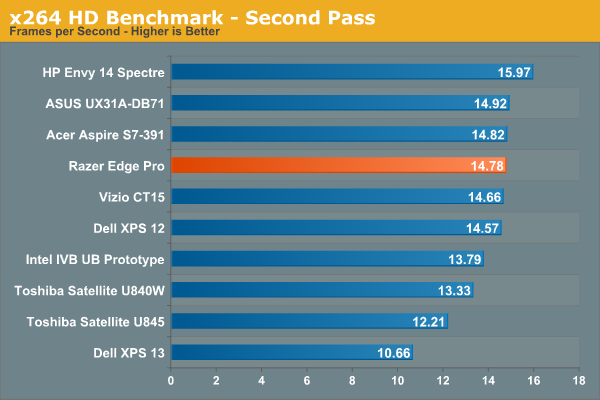

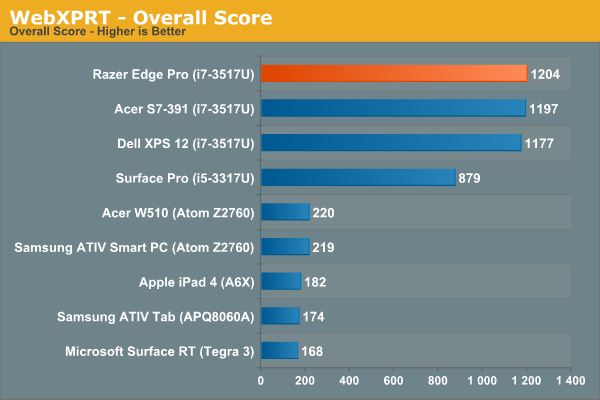
Graphics Performance
Nvidia’s mobile GPU heirarchy can get very, very convoluted, particularly at the low end, with a mix of new, old, and gap-bridging parts all under the same name. As such, there are many variants of GT 640M and GT 640M LE, with a mix of SKUs spanning the 28nm Kepler, 40nm Fermi, and 28nm die-shrunken Fermi cores. An interesting and related side-note: a few days ago, Anand asked the mobile team if we had seen any Kepler-based GT 630M notebooks. It took a bit of searching, but eventually it was determined that none of the GT 630M SKUs are actually Kepler based, only 28nm and 40nm variants of the Fermi core. When the lineups are so jumbled that even we can’t keep track of them, there’s something wrong. Why are some GT 640Ms so slow, while others are nearly equal to the DDR3 GT 650M? Why are there still 40nm GeForce 600M parts? I wish Nvidia could simplify and streamline their mobile GPU lineup, it’d make our lives easier as well as being a lot more transparent for consumers.
The GT 640M LE in the Edge is thankfully a Kepler part, so a 28nm GK107 core with 384 cores, 16 ROPs, and 32 TMUs, just like all Keplers from the GTX 660M on down. This is the absolute bottom of the range, so it has the slowest memory configuration (900MHz DDR3) and a 500MHz core clock, with boost up to 570MHz. The next big hardware jump comes with GDDR5 VRAM in the GT 650M, and a combination of clock speeds and GPU boost make up the differences between SKUs.
The 1366x768 panel comes into play here – Kepler, even at 500MHz, is more than capable of pushing 768p displays at high settings in modern games. High quality textures really start to tax the slower memory in the low-end Kepler cards as you increase resolution, so even with higher clock speeds, 1080p gaming will be non-ideal at best and downright bad at worst. Don’t expect much to be playable, as even the DDR3 variant of the GT 650M basically failed the 1080p portion of our gaming tests. The GDDR5 GT 650M and the GTX 660M (which comes in GDDR5 form only) do better here, but there’s a pretty substantial gap between those two chips and the rest of the GK107 mobile parts at 1080p.
We haven’t yet finalized our 2013 Gaming test suite, so I just ran our 2012 test suite. I did almost all of my testing on the road, sans access to 1080p displays, so I only have 1366x768 gaming results (that’s our value gaming suite, which runs medium detail settings at 768p). I also ran at high detail settings, to see what kind of differences there would be. Once our new suite is finalized, I’ll update with results at 1600x900 and 1080p.
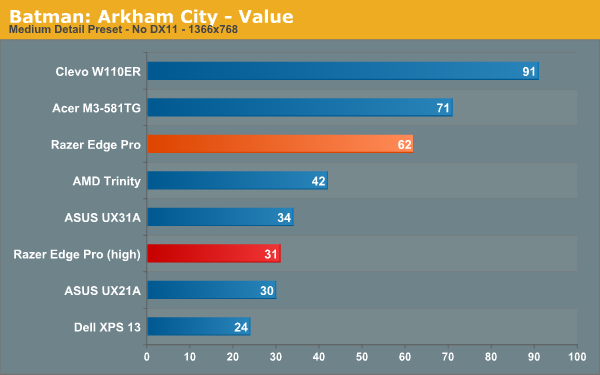
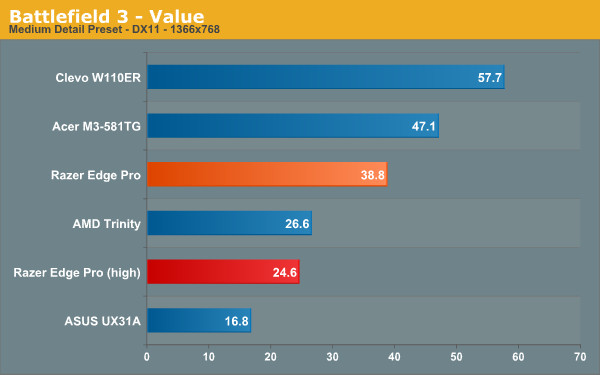
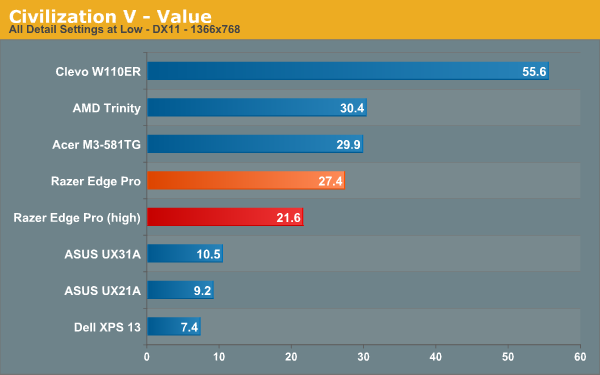
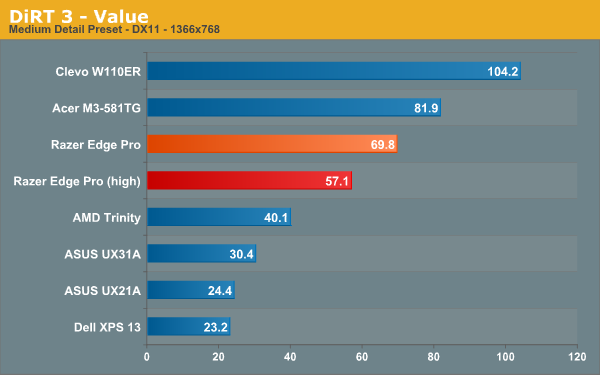

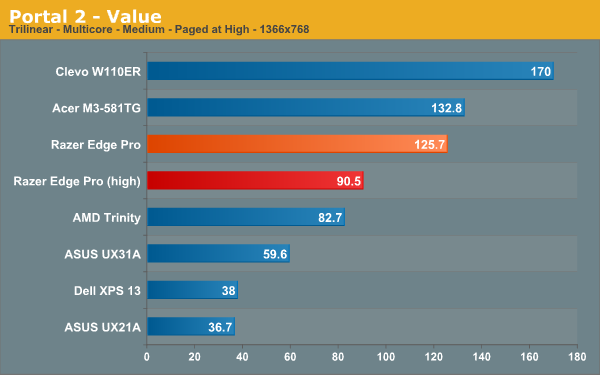
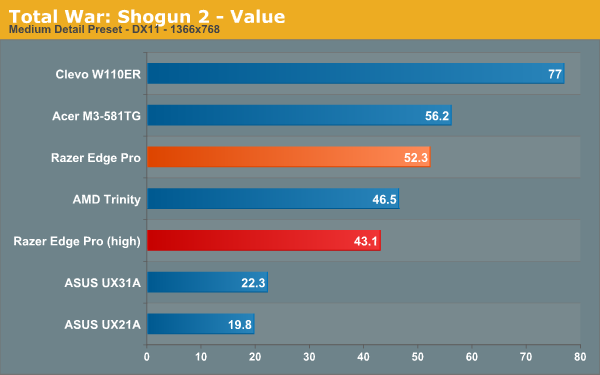
The Edge does pretty well, honestly – Kepler is a great mobile GPU, even clocked so low. At high settings, almost everything was playable, except for Battlefield 3 and Civ 5. I think Civ 5 is CPU limited on the Edge, while BF3 is one of the more strenuous games we test, so both of those were expected. Lower the settings to medium, and pretty much everything is playable.
The higher clock speeds of the GT 650M (DDR3) in the Clevo W110ER really make themselves felt, with substantially better gaming performance than the Edge throughout our benchmark suite. For a comparison with Surface Pro and the other IVB tablets, look at the ASUS Zenbook Primes - the UX31A with the 1.15GHz HD 4000 (i7-3517U) and the UX21A with the same HD 4000 clocked at 1.05GHz (i5-3317U). There's a small performance delta between the two due to the maximum frequency difference, but either way, HD 4000 seriously struggles to be playable in most of our benchmarks unless you lower either the resolution or detail settings. Again, Kepler at 500MHz is still a pretty capable card at 1366x768, so concern over frame rates is probably a moot one unless you’re gaming on an external display.










89 Comments
View All Comments
A5 - Thursday, March 28, 2013 - link
It seems like the 2nd generation of this will be way better, if what half of Intel is saying about Haswell and GT3e is true.VivekGowri - Thursday, March 28, 2013 - link
That's something I wanted to touch on in the conclusion but ran out of time/forgot: GT3e will make the second generation of this really, really interesting. Haswell/GT3e is going to be an awesome combination, but like Anand tweeted, it'll be a while (14nm in 2015) until we get a real best of both worlds solution.A5 - Thursday, March 28, 2013 - link
Yeah, it seems that way. Thanks for the reply.tech.noob.fella - Friday, March 29, 2013 - link
isnt gt3 only for desktops?? i thought gt2 was for portables like this machine...not sure thoughKristian Vättö - Friday, March 29, 2013 - link
GT3 is for laptops too (and even the GT3e). Intel has always focused the best IGPs to mobile CPUs because those systems are the most likely to only feature integrated graphics. Desktops often have a dGPU because there's no heat/space/battery issue, especially if the system is geared towards something graphics intensive (IGPs, even lower-end ones, are fine for basic use).TerdFerguson - Thursday, March 28, 2013 - link
I find this review to be overly generous. Hardware should be reviewed on its merits, not on whether or not you approve of the concept. Asking nearly $2k for this monstrosity is utterly unreasonable.VivekGowri - Thursday, March 28, 2013 - link
It starts at $999, and the most reasonable configuration is $1499 - this honestly isn't that much more than Surface Pro or any of the other high-end Windows 8 tablets. I'd much, much rather pay $1499 for Edge Pro + gamepad than $1199 for the ATIV Smart PC Pro + laptop dock. Surface Pro plus Type Cover for $1139 is probably an equally decent value, but significantly slower (i5/HD4000/4GB vs i7/GT640MLE/8GB) and plays in a completely different market.andrewaggb - Thursday, March 28, 2013 - link
The docks are still the killers for me. At a desk I want to run 2 monitors at 1080p each minimum, preferrably with both 1920x1200 or better. And a usb keyboard and mouse. I could have a dock setup like that at the work office and home office and just drop the tablet in wherever I'm at. Wouldn't care if the tablet screen was disabled when docked running 2 external displays.I would also like a transformer style keyboard dock so I could use it as a laptop.
When I can do all that, with an i7/8gb/256gb+ ssd, it will be sweet. It sucks because I'm sure it could be done now and nobody seems to have done it. Hopefully with haswell... but everybody keeps talking about haswell like it's the second coming, I'm worried it's not going to live up to our expectations.
zanon - Thursday, March 28, 2013 - link
Vivek mentioned Tb, and what you describe is one of the few areas where it'd be really interesting. The dock could itself have a standard graphics card, and thus drive multiple large screens and more powerful gaming while still allowing the tablet part to get away with much less graphics power.15th Warlock - Thursday, March 28, 2013 - link
I have to agree with Terd, while $999 may be the prize of entrance for the Edge experience, the review doesn't actually test the default battery configuration (regardless of it being the pro or non pro version).What this review shows us is a best scenario, using the $250 gamepad attachment and $70 extra battery, that's $320 over the original MSRP, so, even in this scenario you only get 2 hrs of gaming when not plugged to the wall.
The review fails to mention that out of the box this tablet offers only one hour of gaming, and perhaps, less than 3 hrs. of regular use, if razer offered the extra battery with the gamepad attachment it would be a more tolerable proposal, but nickel and diming gamers for the privilege to play for two hrs is way too much, not even Apple limits the user experience in such a way with their overpriced toys...